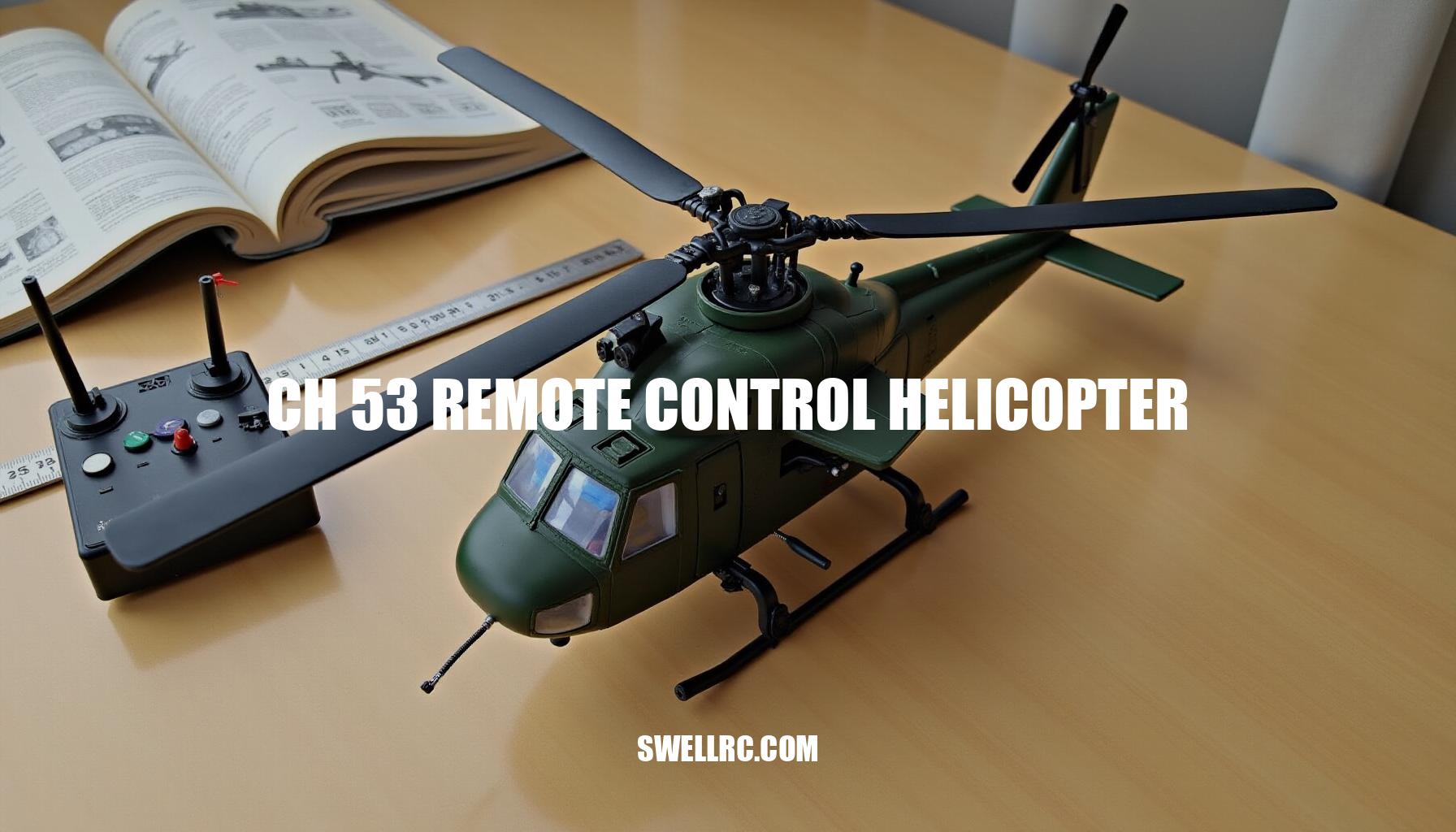CH-53 Remote Control Helicopter: A Guide to Scale Realism and Performance
After hours of researching, flying, and tweaking different RC helicopters, the CH-53 remote control helicopter consistently emerged as the top choice. This model seamlessly blends engineering excellence with a strikingly realistic, military-style design inspired by the iconic Sikorsky heavy-lift helicopter. Among various scale RC models, including notable contenders like the tandem-rotor Boeing Chinook (see here), the CH-53 stands out for its commanding presence in the air, stable performance when properly configured, and a versatile range of configurations catering to pilots across all skill levels.
This comprehensive guide explores the intricate design and advanced electronics that power the CH-53 remote control helicopter, shares firsthand experiences of flying this remarkable remote control aircraft, compares it with popular model helicopters such as the UH-1 and Double Horse 9101, and highlights which versions best suit beginners versus advanced enthusiasts. By the end, you’ll be equipped to decide if the CH-53 is your perfect next RC helicopter and how to maximize its impressive capabilities within your collection of military-style RC helicopters and remote control aircraft.
Deep Dive into the Design and Engineering of the CH-53 RC Helicopter
The CH-53 helicopter model series in the RC hobbyist world is renowned for its large-scale presence and realism, achieved through a variety of sizes and build styles. Central to their appeal is a large, realistic fuselage, often crafted from durable ABS or fiberglass, complemented by internal aluminum and carbon fiber structures that add stiffness while keeping weight to a minimum. These scale RC models utilize advanced brushless electric motor systems that provide reliable and efficient power, paired with traditional gear or belt-driven tail rotors for balanced flight dynamics.
When it comes to rotor configuration, the CH-53 line offers two primary options catering to different skill levels. Beginner pilots can opt for models equipped with a coaxial rotor system, which enhances stability and ease of control through self-stabilizing rotors. More experienced flyers prefer the authentic single main rotor with tail rotor configuration and collective pitch, enabling full control authority and a true-to-scale flying experience.
The electronics setup typically involves multi-channel RC transmitters with 6 to 8 or more channels, supporting essential functions like collective pitch, cyclic control, tail rotor adjustment, flight modes, lighting, and even retractable landing gear where applicable. Many modern models boast built-in gyro stabilization via flybarless units, offering a locked-in and smooth flight feel even in challenging conditions.
To better contextualize where the CH-53 models stand among other large-scale RC helicopters, the following table provides a quick comparison of key specs and typical use cases:
| Model | Rotor system | Typical battery | Channels | Use case |
|---|---|---|---|---|
| CH-53 (coaxial) | Coaxial fixed pitch | 2S LiPo 600–1500 mAh | 3–4 | Beginner-friendly, indoor to calm outdoor |
| CH-53 (collective pitch) | Single main + tail | 3S–6S LiPo 2200–5000 mAh | 6–8+ | Intermediate to pro, scale outdoor |
| UH-1 scale (450–600) | Single main + tail | 3S–6S LiPo 2200–5000 mAh | 6–8+ | Intermediate scale |
| Chinook scale | Tandem rotors | 3S–6S LiPo varies | 6–8+ | Advanced setup, unique flight feel |
In summary, the CH-53 helicopter model line blends large-scale authenticity with cutting-edge RC technology like brushless motors and gyro stabilization, making them an excellent choice for both beginner pilots interested in a coaxial rotor system and seasoned hobbyists seeking full collective pitch control in a large-scale RC helicopter. Their flexible build options and multi-channel control layout ensure a rewarding flying experience tailored to various skill levels and flying environments.
Flying Experience and Performance Insights
My first test sessions with a CH-53 started cautiously—trimming controls, dialing in RC helicopter gyro gains, and checking vibrations. After a few battery packs, the hover steadied, the drift disappeared, and the model settled into that satisfying, scale-like cruise that makes big helicopters so addictive. This flying experience truly highlights the excellent stability and responsiveness of these models.
Here’s what it feels like in the air:
- Takeoff and hover: Coaxial variants lift smoothly with minimal drift, showcasing impressive wind resistance and stability; collective-pitch versions need a touch more finesse but reward you with precise responsiveness.
- Forward flight: The long fuselage tracks beautifully once trimmed, favoring a stately, realistic pace rather than twitchy aerobatics.
- Wind handling: The model’s mass helps outdoors, improving wind resistance; however, it’s best to keep to light-to-moderate breezes unless you’re experienced and properly tuned.
- Sound and presence: The large rotor disk and scale body create a convincing whoop and a commanding silhouette, delivering an authentic outdoor RC helicopter feel.
For those debating between power setups, the decision between electric vs gas RC helicopter options impacts performance and maintenance, so consider your flying environment and preferences carefully.
Comparing the CH-53 to Other Remote Control Helicopters
The CH-53 RC helicopter occupies a unique sweet spot for pilots seeking a large, stable, and realistic flight experience without the mechanical complexity often associated with true tandem rotor systems. When exploring RC helicopter comparisons, the CH-53 stands out for its balance of approachability and scale realism, appealing to a broad range of skill levels.
In direct RC helicopter comparisons, the Double Horse 9101 is a casual, budget-friendly helicopter primarily designed for first-time flyers. The CH-53 in coaxial form offers a similar ease of use but with enhanced scale appeal, making it an excellent choice for beginners who want authentic looks without a steep learning curve. For those who progress, collective-pitch CH-53 builds far exceed the capabilities of budget models.
Compared to the Horizon Hobby AH-64 Apache, which is aggressive and sleek, attracting pilots interested in combat-scale aesthetics and aerobatic potential, the CH-53 emphasizes heavy-lift realism and smooth, scale flights. Additionally, when stacking the CH-53 against the CH-47 Chinook RC helicopter, the latter’s tandem-rotor mechanics make for advanced projects that demand considerable building, tuning, and maintenance skills. The CH-53’s simpler single-rotor layout is easier to handle for most hobbyists, delivering a gratifying flying experience without the complexity.
In the beginner vs. advanced RC helicopters context, micro trainers like the Esky 150 V3 excel for indoor orientation learning, but graduating to a CH-53 brings the benefit of outdoor presence and enhanced realism. For enthusiasts who might prefer speed and range over vertical lift and hover capability, a fixed-wing aircraft like the RC F-35 offers jet thrills though lacks the distinctive hover and vertical-lift thrill that scale helicopter fans cherish.
Here’s a quick overview of who suits each RC helicopter category:
- Beginner: Coaxial CH-53 or budget heli options such as Double Horse 9101
- Intermediate: Collective-pitch CH-53 in the 450–500 class or UH-1 RC helicopter scale builds
- Pro/Scale Enthusiast: Large CH-53 600–700 class with flybarless controllers, lights, and retracts for the most authentic experience
Maintenance, Battery Setup, and Customization Tips
Treat the CH-53 like a real aircraft in miniature and it will reward you with smooth flights and long life. To ensure optimal performance and longevity, following battery for CH-53 RC helicopter and LiPo charging best practices is crucial. When selecting a battery pack, choose one that matches your helicopter’s size class: 2S 600–1500 mAh packs are ideal for small coaxial models, 3S–6S 2200–5000 mAh suits 450–600 class scale helicopters, while larger 6S–12S setups work best for the 700–800 class.
Always charge your batteries at 1C using a balance charger, store them at 3.8V per cell, and avoid discharging below 3.5V per cell under load to maximize battery health.
Regular RC helicopter maintenance is equally important. Before each flight, verify blade tightness, inspect main and tail gear mesh, check tail belt or shaft play, and confirm gyro orientation to minimize vibration. Post-flight, inspect landing gear, skids, and sponsons for cracks, and ensure motor, ESC, and battery temperatures remain within safe limits.
Every 10–20 flights, perform rotor balancing on the main blades, lightly lubricate bearings, and secure fasteners with appropriate thread locker.
If troubleshooting is required, consider these cues: persistent tail wagging may indicate a need to lower gyro gain, check tail linkage slop, or verify blade balance. Vibration during hover calls for re-balancing blades, checking main shaft straightness, and inspecting dampers. Short flight times might be caused by incorrect prop pitch or head speeds, battery health issues, or excessive model weight.
For optimal control, use a reliable helicopter-ready transmitter with at least six channels and model memory. Pairing your CH-53 with a modern flybarless unit offers three-axis stabilization and autorotation-friendly throttle curves. To explore the best helicopter RC remote control options and setup tips, visit https://www.swellrc.com/helicopter-rc-remote-control/.
Customization enhances both scale realism and practicality. Consider matte military paint finishes with weathering and squadron markings. Functional scale features such as LED navigation lights, landing lights, and possible retractable landing gear can add to the authenticity.
Practical add-ons like quick-release battery trays and magnetic canopy mounts allow for faster field swaps and increased flying time.
Conclusion: The Real Reward of Flying the CH-53
What started as curiosity turned into genuine respect for how well the CH-53 remote control helicopter delivers scale helicopter realism and performance. Its engineering — from brushless power and gyro stabilization to sturdy airframes — supports a flying experience that feels big, steady, and purposeful. Compared with casual trainers or aerobatic warbirds, the CH-53 shines when you value scale presence and smooth, confident flight.
If this RC helicopter guide sparked ideas, explore more related models across SwellRC for inspiration and next steps.
Consider the benefits of:
- Exploring large-scale RC helicopters for enhanced realism and flight stability.
- Experimenting with tuning and finishes to perfect your craft.
- Building on the foundation of brushless power and gyro stabilization to achieve rock-solid performance.
The journey from first hover to rock-solid scale passes is the real reward for any enthusiast pursuing authentic scale helicopter realism.
Frequently Asked Questions
- How hard is it to fly a CH-53 remote control helicopter?
Difficulty depends on configuration. Coaxial CH-53 variants are beginner-friendly with built-in stability. Collective-pitch, single-rotor versions require orientation practice, throttle/collective management, and proper gyro setup. A simulator, conservative dual rates, and training gear shorten the learning curve. - What makes the CH-53 different from the CH-47 Chinook RC helicopter?
The CH-53 is a single-main-rotor helicopter with a tail rotor, while the CH-47 Chinook uses tandem main rotors. Tandem mechanics change how the model flies and add build complexity. Many pilots find the CH-53 simpler to set up and maintain, while the Chinook offers unique twin-rotor character. See https://www.swellrc.com/boeing-ch-47-chinook-rc-helicopter/ for context. - Are there large-scale versions of the CH-53 RC helicopter?
Yes. Large-scale CH-53 kits and ARFs exist in 600–800 classes and beyond. They typically use 6S–12S LiPo power, robust servos, and flybarless controllers. Build time, cost, and transport needs increase with size. For a size comparison perspective, see large tandem options here: https://www.swellrc.com/large-scale-chinook-rc-helicopter/. - Which batteries and controllers work best with this helicopter?
Match the battery to the model’s size: 2S for small coaxials, 3S–6S for 450–600 class, and 6S–12S for 700–800 class. Use a quality balance charger and keep storage voltage around 3.8V per cell. A 6–8+ channel transmitter with helicopter mixes and a modern flybarless unit provides the best control. Controller guidance: https://www.swellrc.com/helicopter-rc-remote-control/. - Can a CH-53 RC helicopter be modified for advanced stunts?
Coaxial CH-53 models cannot perform aerobatics. A collective-pitch CH-53 with sufficient head speed, strong servos, and a tuned flybarless controller can do loops and rolls, but heavy scale bodies are not ideal for extreme 3D. Most pilots prioritize smooth, realistic flight over stunt performance with this airframe.



